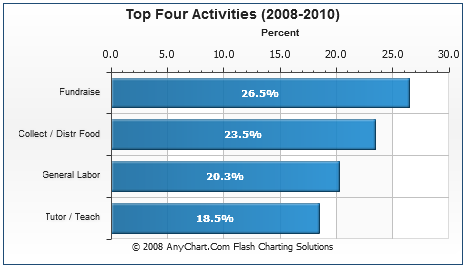Every year, the nonprofit Independent Sector releases an estimated value of volunteer time: for 2011, that calculation is $21.79 per hour of volunteerism. This rate is an estimate based on the U.S. Bureau of Labor Statistics occupational wage data. It averages the hourly wages for all production, non-supervisory, non-farm occupations across the United States, with an extra 12 percent added for fringe benefits. Organizations across the nation use the rate to track, measure, and value volunteer efforts.
As Independent Sector explains, "This is only a tool and only one way to show the immense value volunteers provide to an organization." So, what are the benefits and limitations of Independent Sector's estimate in effectively quantifying volunteer activities?
Benefits
1. Visibility
Despite the cultural resistance to measuring altruistic activity with dollars, there are clear benefits to monetizing volunteer labor. As VolunteerMatch president Greg Baldwin argues, giving volunteerism an “hourly wage” provides visibility to volunteers as an economic force in our communities. So long as volunteers are “invaluable,” their contribution cannot be fully recognized and respected.
2. Credibility
The Independent Sector rate is also nationally recognized and credible. Nonprofits can use an externally determined rate to communicate their economic contributions to funders, participants, and community stakeholders – and to volunteers themselves.
3. Simplicity
One national rate enables organizations to measure their productive value, including volunteer time, with one simple, unbiased, and transparent number. It couldn’t be easier to multiply the number of volunteer hours by one hourly rate.
Limitations
1. Simplicity masks valuable opportunities to increase volunteer value
The simplicity of one annual valuation for volunteers is tempting. But a single hourly rate masks the relative value of vastly different volunteer activities. According to the Corporation for National and Community Service, the top four volunteer activities in 2008-2010 were fundraising, food distribution, general labor, and tutoring and teaching.

Source: Volunteering in the U.S.
Compared to the Bureau of Labor Statistics mean wages for the four major volunteer activities (see table below), the Independent Sector rate overvalues general labor and food sorting and distribution and undervalues fundraising. One average rate can’t represent the diversity of volunteerism or the relative value of particular activities to a nonprofit organization.
|
Top Volunteer Activities |
Independent Sector Rate |
BLS Occupation |
Mean Wage |
Percent Difference |
|
Fundraising |
$21.79 |
$50.81 |
- 133% |
|
|
Food sorting and distribution |
$21.79 |
$10.81 |
+ 50% |
|
|
General labor |
$21.79 |
$12.29 |
+ 44% |
|
|
Tutoring and teaching |
$21.79 |
$19.73 |
+ 9% |
2. Excludes important elements of skills-based volunteerism
Finally, because the Independent Sector rate removes the supervisory occupations that most closely describe board service and pro bono volunteerism, the Independent Sector rate is ill fitted to the national shift towards high-impact skills-based volunteerism, and compounds the masking of leverage opportunities noted above.
3. Activities are outputs, not outcomes
As in business, focusing on bottom-line outcomes is key to quantifying social value. Instead of dollars spent, volunteer hours invested, or nonprofit partnerships created, assessing how your program ultimately improves education, the community, or other social cause is what measures the return on that investment. With short-duration volunteer projects, long-term outcome measurement is impractical.
What’s left is assessing the market value of the activities being performed. The BLS dataset is the most comprehensive, detailed, and current dataset available for valuing volunteer activities, but it reflects wage rates (what an employer pays its employees) not market rates (what it would cost to hire a contractor or services firm) – with the latter being a better representation of the services being provided by a volunteer.
As Independent Sector states, its estimated value of a volunteer hour is but one way to show the value volunteers provide to an organization. Understanding the strengths and limitations of the approach will help you decide when it’s the appropriate value for you to use.
Follow our detailed discussion of the BLS dataset for measuring volunteerism here.



